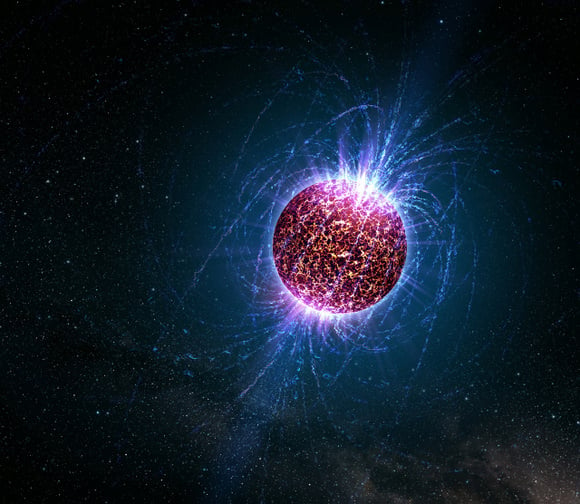[/caption] Neutron stars are dying stars that are seemingly 'off the charts' in almost every category. They are small and extremely dense; about 20 km in diameter with masses of about 1.4 times that of our Sun, meaning that on Earth, one teaspoon of a neutron star would weigh about 100 million tons. They also rotate exceeding fast, about 700 times per second. And according to a new study, neutron stars have another almost super-hero like quality: the outer surface of these collapsed stars is likely to be 10 billion times stronger than steel or any other of Earth's strongest alloys.
Neutron stars are massive stars exhibiting extreme gravity. They have collapsed inward once their cores ceased nuclear fusion and energy production. The only things more dense are black holes.
Scientists want to understand the structure of neutron stars, in part, because surface irregularities, or mountains, in the crust could radiate gravitational waves and in turn may create ripples in space-time. Understanding how high a mountain might become before collapsing from the neutron star's gravity, or estimating the crust's breaking strain, also has implications for better understanding star quakes or magnetar giant flares.
Charles Horowitz, a professor in Indiana University conducted several large-scale molecular dynamics computer simulations and determined the crust of neutron stars is extremely strong.
"We modeled a small region of the neutron star crust by following the individual motions of up to 12 million particles," Horowitz said of the work conducted through IU's Nuclear Theory Center in the Office of the Vice Provost for Research. "We then calculated how the crust deforms and eventually breaks under the extreme weight of a neutron star mountain."
Performed on a large computer cluster at Los Alamos National Laboratory and built upon smaller versions created on special-purpose molecular dynamics computer hardware at IU, the simulations identified a neutron star crust that far exceeded the strength of any material known on earth.
The crust could be so strong as to be able to elicit gravitational waves that could not only limit the spin periods of some stars, but that could also be detected by high-resolution telescopes called interferometers, the modeling found.
"The maximum possible size of these mountains depends on the breaking strain of the neutron star crust," Horowitz said. "The large breaking strain that we find should support mountains on rapidly rotating neutron stars large enough to efficiently radiate gravitational waves."
Because of the intense pressure found on neutron stars, structural flaws and impurities that weaken things like rocks and steel are less likely to strain the crystals that form during the nucleosynthesis that occurs to form neutron star crust. Squeezed together by gravitational force, the crust can withstand a breaking strain 10 billion times the pressure it would take to snap steel.
The research will appear Friday (May 8) in Physical Review Letters.
See an online version of the Horowitz's research paper,
"The breaking strain of neutron star crust and gravitational waves."
Source:
EurekAlert
 Universe Today
Universe Today
